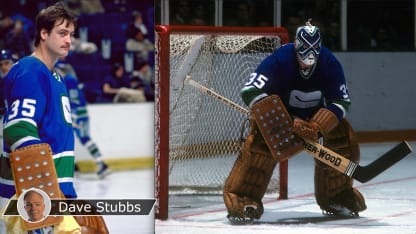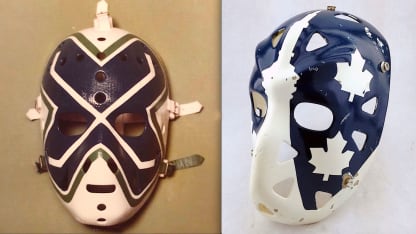It was in Vancouver that Ridley famously had a fiberglass mask molded and painted by Greg Harrison, who built and customized many of the great masks of the era.
Hugely popular with Canucks fans, the mask played on the team's stick-in-rink jersey crest, its two double-bladed crossed sticks painted on a green-trimmed blue background designed to resemble a four-leaf clover.
Harrison would produce a few other shapes and paint schemes for Ridley, whose Canucks original was painted plain white when he was traded to the Maple Leafs for cash on Feb. 10, 1980. The final six games of the goalie's NHL career in Toronto included a blue and white model featuring four maple leaves and the city's iconic CN Tower, stretching from mouth to forehead.
No matter the design, Ridley's masks certainly were a step up from what he'd worn in the minor leagues, where a shot in Providence sliced off part of his ear that was retrieved from the goal crease by a trainer and given to a surgeon for emergency reattachment.
Finishing with Cincinnati in the Central League in 1981-82, Ridley told hockey writer George Grimm in 2014 that he "didn't really retire. No one contacted me and I didn't contact them, so it was over. I just walked away from the game and it walked away from me."
Watch: Curt Ridley Induction into Manitoba Hockey Hall of Fame
Ridley was 27-47-16 with a 3.88 goals-against average and .872 save percentage in the NHL. He had one shutout, a 5-0 win for the Canucks against the California Golden Seals on April 2, 1976, and was inducted into the Manitoba Hockey Hall of Fame in 2015.
Ridley settled in Winnipeg early in retirement, selling telephone systems and wireless communications until the cold winters took him to Dallas, where he and his wife attended Stars games. He joined Facebook and had nearly 1,500 friends on that platform, often engaging enthusiastically with fans about his days playing hockey and the game today. Many assembled there upon news of his death to express their sadness and share their memories.
"As a player I was average, maybe a little less," Ridley told Grimm. "I had my moments. I also had some bad moments. I didn't think I'd ever play in the NHL, so it was all a plus. I met great people on and off the ice. I met some great booster-club people who were just fantastic.
"It was a great experience playing against Bobby Orr, Phil Esposito, Marcel Dionne, Lanny McDonald … I could go on and on. It was a kid's dream. I played against Gordie Howe, for God's sake. It was a dream that had come true."
Photos: Hockey Hall of Fame: O-Pee-Chee, Lewis Portnoy; Getty Images; gregharrisonthemask Instagram; Manitoba Hockey Hall of Fame





